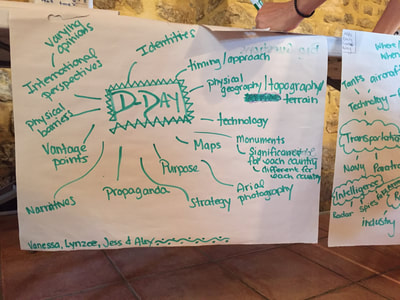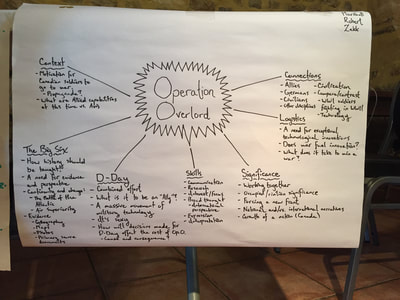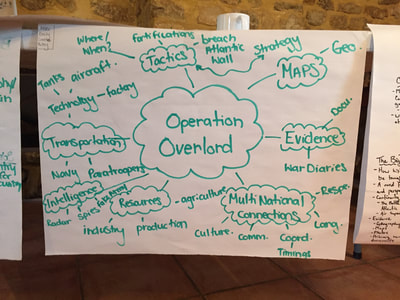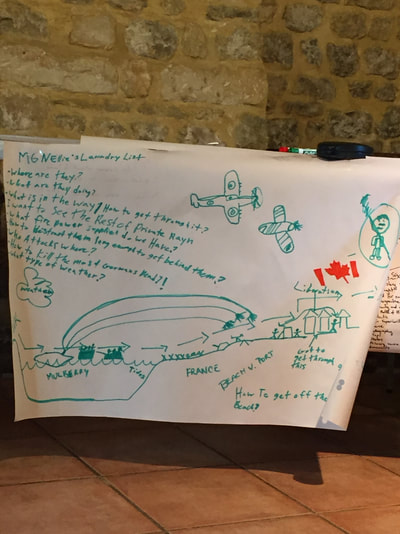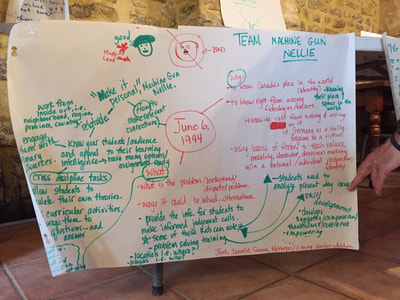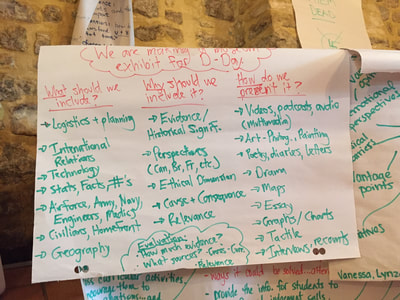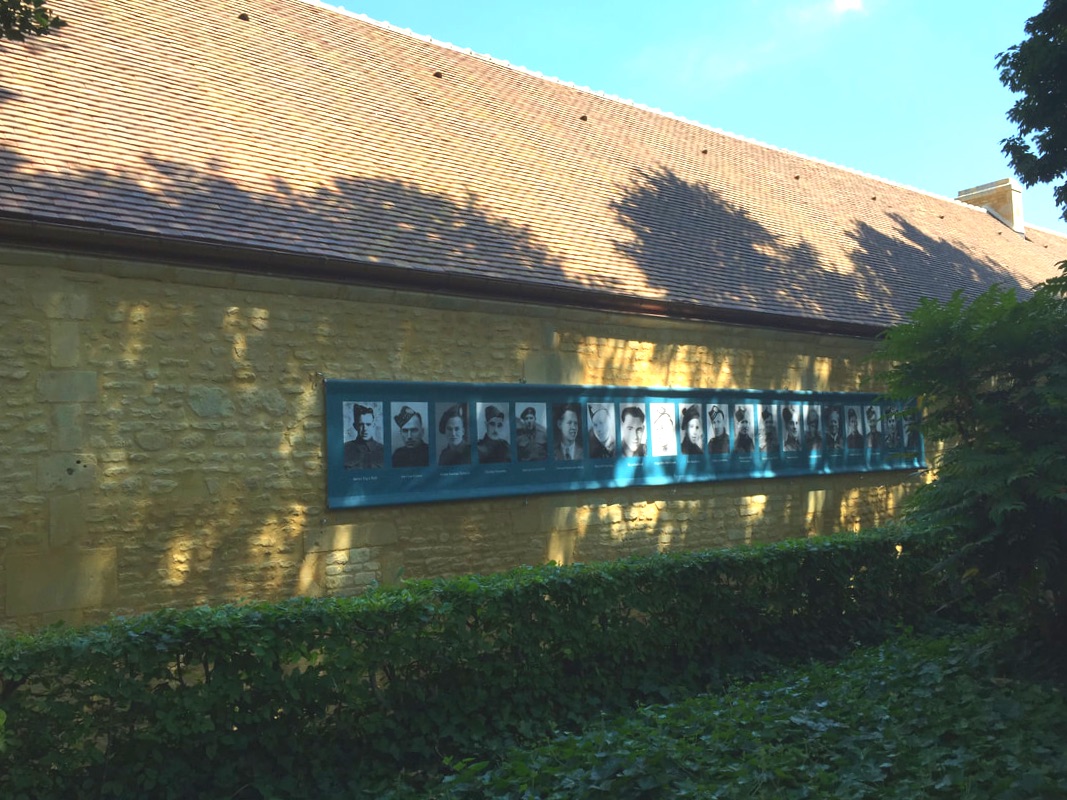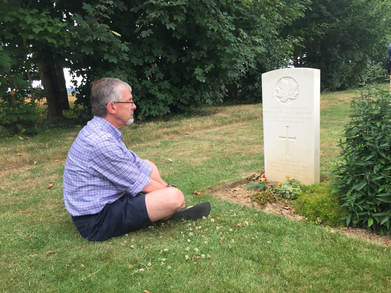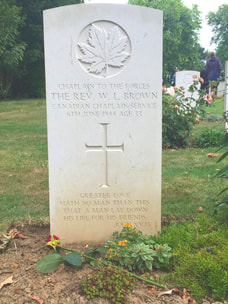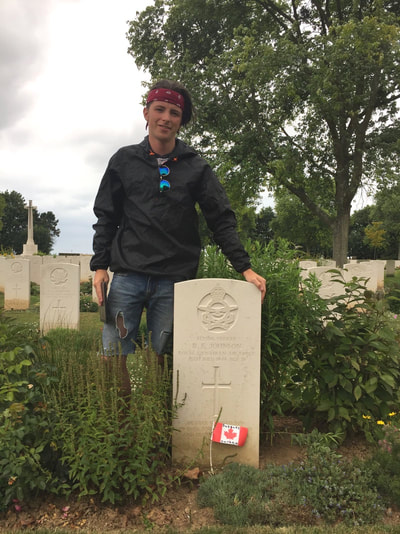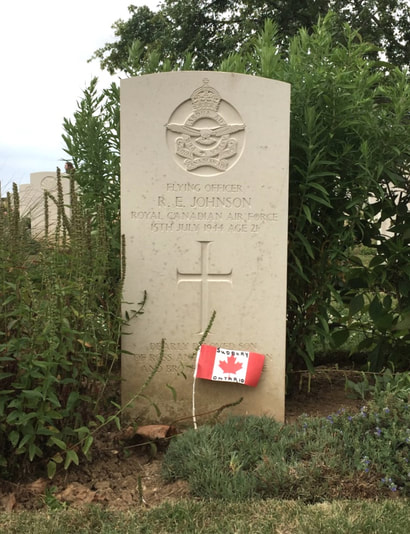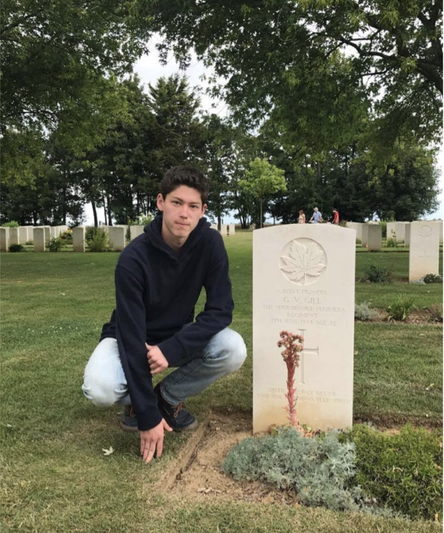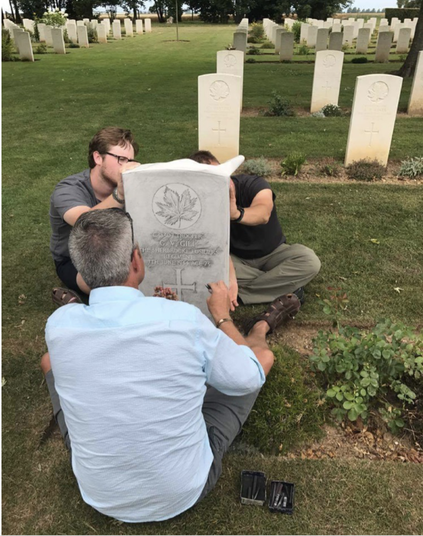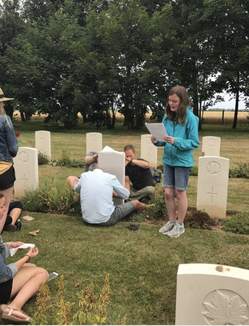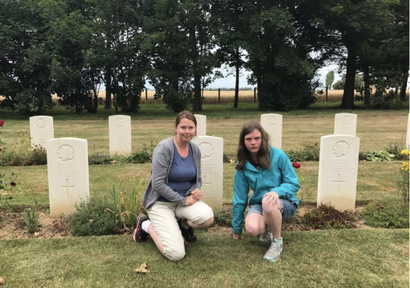"We must question everything that is delivered to us."
Today's Itinerary and Activities
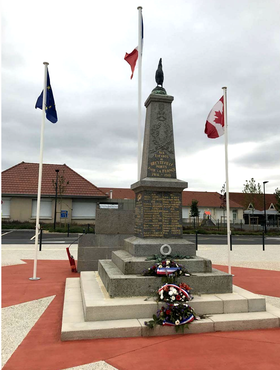 The cenotaph in Bretteville's town square
The cenotaph in Bretteville's town square
Today we gained insights into authentic problem solving.
Our day began in the classroom where syndicates presented their operational plans for Operation Overlord. Following the presentations, syndicates received copies of orders, maps, and air photographs issued in 1944. Lee then introduced our next activity: a Tactical Exercise Without Troops (TEWT). After he gave us an intelligence brief, syndicates quickly got into the vans. We spent the next hour or so stopping at various landmarks such as churches and railways to get a sense of the ground.
At the conclusion of the TEWT, we drove to Bretteville and settled into a coffee shop. Over the next hour, syndicates used the observations that they had made during the TEWT and the primary research documents that they had received at the Moulin Morin to prepare a battalion-level defence plan. At the end of the work period, syndicates came together and presented their defence plans to the whole group.
Our day continued with a visit to the Abbaye d'Ardenne (Ardenne Abbey), a Second World War memorial that commemorates twenty Canadians who were executed by the 12th SS Panzer Division during the first days of the Normandy Campaign. While at the Abbaye d'Ardenne, we explored the buildings, the museum, the abbey's gardens, and the memorial to the twenty assasinated Canadians. We also considered a question posed by Cindy: What was at stake for the Germans?.
Our day ended at the Bény-sur-Mer Canadian War Cemetery. After Simon, Janelle, Ben, and Andrew presented biographical sketches of the soldiers they had researched, Lorelei guided a group discussion about integrity and empathy during periods of war.
Our day began in the classroom where syndicates presented their operational plans for Operation Overlord. Following the presentations, syndicates received copies of orders, maps, and air photographs issued in 1944. Lee then introduced our next activity: a Tactical Exercise Without Troops (TEWT). After he gave us an intelligence brief, syndicates quickly got into the vans. We spent the next hour or so stopping at various landmarks such as churches and railways to get a sense of the ground.
At the conclusion of the TEWT, we drove to Bretteville and settled into a coffee shop. Over the next hour, syndicates used the observations that they had made during the TEWT and the primary research documents that they had received at the Moulin Morin to prepare a battalion-level defence plan. At the end of the work period, syndicates came together and presented their defence plans to the whole group.
Our day continued with a visit to the Abbaye d'Ardenne (Ardenne Abbey), a Second World War memorial that commemorates twenty Canadians who were executed by the 12th SS Panzer Division during the first days of the Normandy Campaign. While at the Abbaye d'Ardenne, we explored the buildings, the museum, the abbey's gardens, and the memorial to the twenty assasinated Canadians. We also considered a question posed by Cindy: What was at stake for the Germans?.
Our day ended at the Bény-sur-Mer Canadian War Cemetery. After Simon, Janelle, Ben, and Andrew presented biographical sketches of the soldiers they had researched, Lorelei guided a group discussion about integrity and empathy during periods of war.
Chart Paper and Markers: Two Simple and Effective Teaching Tools
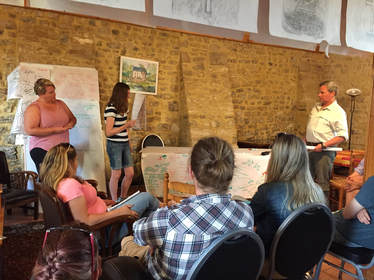 With the support of Kathryn and Joel, Janelle (centre) presents her syndicate's Operation Overlord operational plan
With the support of Kathryn and Joel, Janelle (centre) presents her syndicate's Operation Overlord operational plan
During the presentation of their operational plans, syndicates shared a range of Big Ideas and Powerful Questions related to Operation Overlord. As you will notice in the images below, syndicates recorded their ideas on chart paper using whiteboard markers.
Chart paper and markers are teaching supplies that lend themselves to both whole-class discussions and small group work. These simple tools allow students to write down and draw out their ideas and questions for everyone to see. The mind maps become living documents that can be added to over time.
Also important to note is that the mind maps become a record of learning and can be used to assess students' knowledge and skill development. As well, teachers can use the Big Ideas, Historical Thinking Concepts, and Powerful Questions that their students write down to plan for future lessons and projects.
Chart paper and markers are teaching supplies that lend themselves to both whole-class discussions and small group work. These simple tools allow students to write down and draw out their ideas and questions for everyone to see. The mind maps become living documents that can be added to over time.
Also important to note is that the mind maps become a record of learning and can be used to assess students' knowledge and skill development. As well, teachers can use the Big Ideas, Historical Thinking Concepts, and Powerful Questions that their students write down to plan for future lessons and projects.
Tactical Exercise Without Troops: An Authentic Learning Activity
 (Clockwise from left) Abbi, Riley, and Emily present their syndicate's defence plan
(Clockwise from left) Abbi, Riley, and Emily present their syndicate's defence plan
The tactical exercise that we participated in today is an example of an authentic problem solving activity. After syndicates presented their defence plans, Blake explained that it is essential for teachers to engage their students in authentic problem solving activities because such exercises are skills-driven and collaborative in nature. As well, they enable students to analyze different historical perspectives, wrestle with ethical dilemmas, and work with primary source evidence.
As a large group, we brainstormed how teachers can bring the same tactical exercise that we completed - or a similar activity - into the walls of their Canadian classrooms:
A few participants also pointed out that to engage their students in other authentic problem solving activities, teachers can ask their students to solve problems that their own municipal government and neighbours resolved.
As a large group, we brainstormed how teachers can bring the same tactical exercise that we completed - or a similar activity - into the walls of their Canadian classrooms:
- Teachers can access and present their students with authentic evidence packages that include the maps, photographs, and orders that the 1939-1945 Canadian troops received.
- Students can study the geography and topography of battlegrounds using Google Maps
- Teachers can ask students to respond to several Powerful Questions using primary source evidence to back up their responses. Lee shared a few of these questions with us:
- Where would you attack?
- Where would you defend?
- How would you protect your civilians?
- Are there buildings and land that are more strategically important to keep safe than others? Why?
- Teachers can ask students to create a civil affairs plan. Cindy shared some questions for students to consider when creating their plans:
- What steps do you take to rebuild your town?
- What are the priorities?
- How do you acquire a labour force?
- How do you house returning civilians during the reconstruction process when their homes are destroyed?
A few participants also pointed out that to engage their students in other authentic problem solving activities, teachers can ask their students to solve problems that their own municipal government and neighbours resolved.
The Abbaye d'Ardenne
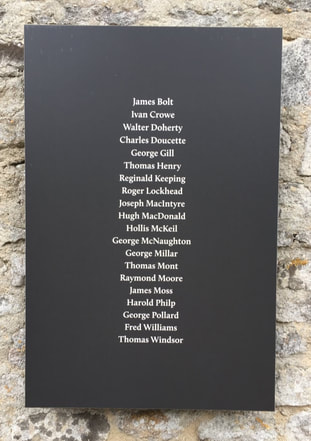 This plaque commemorates the twenty men who were executed at the Abbaye d'Ardenne on the 7, 8, and 17 June 1944
This plaque commemorates the twenty men who were executed at the Abbaye d'Ardenne on the 7, 8, and 17 June 1944
The Abbaye d'Ardenne, which consists of multiple medieval buildings, a memorial park, a museum, and gardens, is historically significant because twenty Canadian Prisoners of War were murdered onsite on the 7, 8, and 17 June 1944 by a Hitler Youth Division, the 12th SS Panzer Division. The twenty Canadians all belonged to the North Nova Scotia Highlander Regiment; the 27th Canadian Armoured Regiment; and the Stormont, Dundas and Glengarry Highlander Regiment. The Royal Regina Rifles liberated the Abbaye d'Ardenne on 8 July 1944.
When asked for their thoughts on the Abbaye d'Ardenne, Emily and Mike reflected on the events that took place there:
When asked for their thoughts on the Abbaye d'Ardenne, Emily and Mike reflected on the events that took place there:
- Emily: "Visiting the Abbaye d'Ardenne and learning of the massacre that took place there were two of the most emotional experiences I've had. The horror that the twenty men were put through will carry on in my thoughts for a long time. It took me a while after we left to gather my thoughts and not feel disturbed about all the things I had read about in the museum. Abbaye d'Ardenne left me with many questions that I will continue to ponder for a long time."
- Mike: "Abbaye d'Ardenne represents the length that the Nazis went to in order to intentionally dehumanize their elite. This cold, calculated act was more a statement to their own men that defeat was not an option. It speaks to the question Why do we fight? from the perspective of the aggressor. The Germans knew they were going to have a tough road ahead if they were to push the Allies back. I liken this to Cortez burning his ships to let his men know that there was not an option of turning back. This heinous act is symbolic of the stakes of the conflict. The ideological commitment that the Nazi SS had was stronger than the commitment to humanity."
What was at stake for the Germans?
Before we disperse to investigate the Abbaye d'Ardenne, Cindy posed the question What was at stake for the Germans?.
Following our visit to the Abbaye, Marshall and Zakk shared their responses to Cindy's question.
Following our visit to the Abbaye, Marshall and Zakk shared their responses to Cindy's question.
- Marshall: "The Germans could not afford to give up their positions on the D-Day landing beaches because they were faltering in the Italian Campaign. As well, the close-in of the Allies on the Germans, who had built up the Atlantic Wall, would trigger the end of the Second World War."
- Zakk: "Everything was at stake for the Germans. Until this point in time, the Germans had instituted policies of grave inhumanity, cold indifference, and incalculable depravity. Their blatant war crimes meant that when they lost the war, the righteous hammer of the new, combined world order (vis à vis the United Nations) crushed them."
Soldier Biographies
Simon's Soldier
Reverend Walter Leslie Brown
Canadian Chaplain Service
Bény-sur-Mer Canadian War Cemetery
Reverend Walter Leslie Brown
Canadian Chaplain Service
Bény-sur-Mer Canadian War Cemetery
I was one of the last presenters to talk about his soldier, which gave me more time to prepare. Indeed, almost everyday, I tweaked and tinkered with the bio, adding new information, doing more research, changing this or that, … On the morning of the presentation, I was still working on it! When it was time to deliver, and as soon as I found the tombstone at the Bény-sur-Mer cemetery, I saw the word ‘’Reverend’’ on the tombstone and it choked me, which set the mood for the entire presentation. It was really difficult to contain my sadness and the injustice of it all, especially after our visit at the Abbaye d’Ardennes. It was an emotional time, a sad time and I am proud to have presented Honorary Captain Walter Leslie Brown to the entire group. The visit at his tombstone might have been the only one since his death."
Ben's Soldier
Ross Eveleigh Johnson
Royal Canadian Air Force, 438 Squadron
Bény-sur-Mer Canadian War Cemetery
Ross Eveleigh Johnson
Royal Canadian Air Force, 438 Squadron
Bény-sur-Mer Canadian War Cemetery
Andrew's Soldier
Trooper George Vincent Gill
Sherbrooke Fusiliers Regiment, R.C.A.C.
27th Armoured Regiment
Bény-sur-Mer Canadian War Cemetery
Trooper George Vincent Gill
Sherbrooke Fusiliers Regiment, R.C.A.C.
27th Armoured Regiment
Bény-sur-Mer Canadian War Cemetery
Janelle's Soldier
Rifleman Russell George McCallum
Queen's Own Rifles of Canada, R.C.I.C.
Bény-sur-Mer Canadian War Cemetery
Rifleman Russell George McCallum
Queen's Own Rifles of Canada, R.C.I.C.
Bény-sur-Mer Canadian War Cemetery
Seminar
At the end of our visit to the Bény-sur-Mer Canadian War Cemetery, Lorelei facilitated a seminar. She posed the following two questions:
- How do we reconcile integrity, values, and ethics in a time of war with the juxtaposition of the absolute horrors of the killing (which we have learned is "necessary")?
- Is there room for empathy in war?
Gallery
Where we are |
Contact Us |
